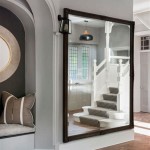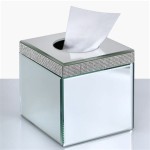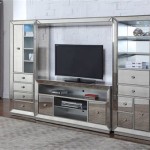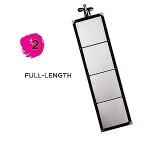How to Frame an Existing Bathroom Mirror
Framing an existing bathroom mirror is a relatively straightforward and cost-effective way to enhance the aesthetic appeal of a bathroom without the expense and effort of replacing the mirror entirely. This project can transform a plain, builder-grade mirror into a focal point, adding character and style to the space. The process involves careful measurement, material selection, precise cutting and assembly, and secure attachment to the mirror. While the task is generally suitable for DIY enthusiasts with basic carpentry skills, careful planning and attention to detail are crucial for achieving a professional-looking result.
Before commencing the framing process, it is essential to assess the existing mirror and bathroom environment. Consider the size and shape of the mirror, the existing décor of the bathroom, and the desired aesthetic for the framed mirror. These factors will influence the choice of materials, the style of the frame, and the method of attachment. Improper planning can lead to a frame that clashes with the bathroom's overall design or is unsuitable for the mirror's dimensions.
Key Point 1: Measurement and Material Selection
Accurate measurement is the foundation of a successful mirror framing project. Begin by measuring the exact dimensions of the mirror. Measure both the height and width in multiple locations to account for any irregularities. Record the largest measurements to ensure the frame completely covers the mirror edges. This step prevents gaps between the frame and the mirror, resulting in a cleaner, more professional finish.
Once the mirror's dimensions are established, determine the desired width of the frame. This will affect the overall size of the frame pieces required. A wider frame can create a bolder statement, while a narrower frame offers a more subtle enhancement. Consider the scale of the bathroom and the mirror's size when deciding on the frame width. A small bathroom may be overwhelmed by an excessively wide frame.
The selection of framing material is paramount to the project's outcome. Several options are available, each offering distinct advantages and disadvantages. Wood is a popular choice due to its versatility, ease of workability, and ability to be painted or stained. Common wood types include pine, poplar, and hardwood. Pine is a relatively inexpensive option suitable for painting, while denser hardwoods like oak or maple offer greater durability and a more refined aesthetic when stained.
MDF (Medium-Density Fiberboard) is another viable option, particularly for painted frames. MDF is less prone to warping and splitting than natural wood, and its smooth surface provides an excellent base for paint. However, MDF is more susceptible to water damage, making it less suitable for bathrooms with poor ventilation or high humidity levels.
PVC trim is a moisture-resistant alternative, ideal for bathrooms prone to humidity and splashes. PVC trim is available in various profiles and can be cut and assembled using similar techniques as wood. While PVC is not as aesthetically versatile as wood, it offers superior resistance to warping, rotting, and insect damage. It is also readily paintable.
When selecting the frame profile, consider the existing décor of the bathroom. Simple, clean lines complement modern or minimalist bathrooms, while more ornate profiles suit traditional or classic styles. Common frame profiles include flat, rounded, and stepped designs. Pre-made moulding is available at most home improvement stores, offering a wide range of styles and materials.
In addition to the framing material, appropriate adhesive is crucial for attaching the frame to the mirror. Mirror mastic is a specialized adhesive designed specifically for adhering mirrors to various surfaces. It provides a strong, permanent bond without damaging the mirror's reflective coating. Avoid using generic construction adhesives, as they may contain chemicals that can degrade the mirror's backing and cause discoloration.
Key Point 2: Cutting and Assembling the Frame
Precision cutting is essential for creating a professional-looking frame. A miter saw is the ideal tool for cutting the frame pieces at 45-degree angles, creating clean, seamless corners. If a miter saw is unavailable, a hand saw and miter box can be used, although achieving precise angles may require more skill and effort.
Before cutting the frame pieces, double-check the measurements to ensure accuracy. Calculate the required length of each piece by adding the width of the frame material to the mirror's dimensions. For example, if the mirror is 24 inches wide and the frame material is 2 inches wide, the outer length of the frame pieces will be 28 inches. Remember that the 45-degree miter cuts will slightly shorten the visible length of the frame pieces.
Cut the four frame pieces, ensuring that the mitered ends are clean and square. Use sandpaper to smooth any rough edges and ensure a tight fit at the corners. Dry-fit the frame pieces around the mirror to verify the accuracy of the cuts and make any necessary adjustments. This step is crucial for identifying and correcting any discrepancies before applying adhesive.
Once the frame pieces are cut and fitted, assemble them using wood glue and clamps. Apply a thin bead of wood glue to the mitered ends of the frame pieces and join them together, forming a rectangular frame. Use clamps to hold the frame securely in place while the glue dries. Ensure that the corners are aligned properly and that the frame is square. Wipe away any excess glue with a damp cloth.
Allow the glue to dry completely according to the manufacturer's instructions. This typically requires several hours, or preferably overnight. Once the glue is dry, remove the clamps and inspect the frame for any gaps or imperfections. Fill any gaps with wood filler, allow it to dry, and sand it smooth. Prepare the frame for finishing by sanding it lightly with fine-grit sandpaper. This will create a smooth surface for paint or stain.
Apply the desired finish to the frame, following the manufacturer's instructions. If painting the frame, apply a primer coat followed by two coats of paint, allowing each coat to dry completely before applying the next. If staining the frame, apply the stain evenly with a brush or cloth, and wipe away any excess. Apply a clear topcoat to protect the finish and enhance its durability.
Key Point 3: Attaching the Frame to the Mirror
Before attaching the frame to the mirror, clean the mirror surface thoroughly with glass cleaner. Remove any dust, dirt, or fingerprints that may prevent proper adhesion. Ensure that the mirror is completely dry before proceeding.
Apply mirror mastic to the back of the frame, following the manufacturer's instructions. Apply a generous amount of adhesive in a continuous bead around the perimeter of the frame, as well as several beads across the center of the frame. This will ensure a strong, even bond between the frame and the mirror.
Carefully position the frame onto the mirror, aligning it precisely with the mirror's edges. Press the frame firmly against the mirror, applying even pressure to ensure good contact between the adhesive and the mirror surface. Use painter's tape to secure the frame to the mirror, holding it in place while the adhesive dries.
Allow the mirror mastic to dry completely according to the manufacturer's instructions. This typically requires 24 to 48 hours. During this time, avoid moving or disturbing the mirror to prevent the frame from shifting or detaching.
Once the adhesive is dry, remove the painter's tape and inspect the frame for any signs of loose adhesion. If any areas are not securely attached, apply additional mirror mastic and re-tape the frame until the adhesive has fully cured.
Caulk the inside edge of the frame where it meets the mirror with a bead of paintable caulk. This will provide a clean finished look and seal out any moisture.
With the frame securely attached and the adhesive fully cured, the newly framed bathroom mirror is ready to be enjoyed. The transformation from a plain, unframed mirror to a stylish, framed accent piece will undoubtedly enhance the aesthetic appeal of the bathroom.

How To Frame Out That Builder Basic Bathroom Mirror For 20 Or Less

Bathroom Mirror Frames 2 Easy To Install Sources A Diy Tutorial Retro Renovation

Diy Stick On Mirror Frame Sawdust Sisters

Mirror Frame Diy How To Update A Basic Bathroom Our Faux Farmhouse

Diy Bathroom Mirror Frame Without Removing Clips Her Happy Home

Diy Mirror Frame Remodelaholic

Easy Diy Tutorial Adding Trim Around A Giant Mirror For Ers

How To Frame A Bathroom Mirror

How To Frame Out That Builder Basic Bathroom Mirror For 20 Or Less

Diy Bathroom Mirror Frame With Molding The Happier Homemaker








